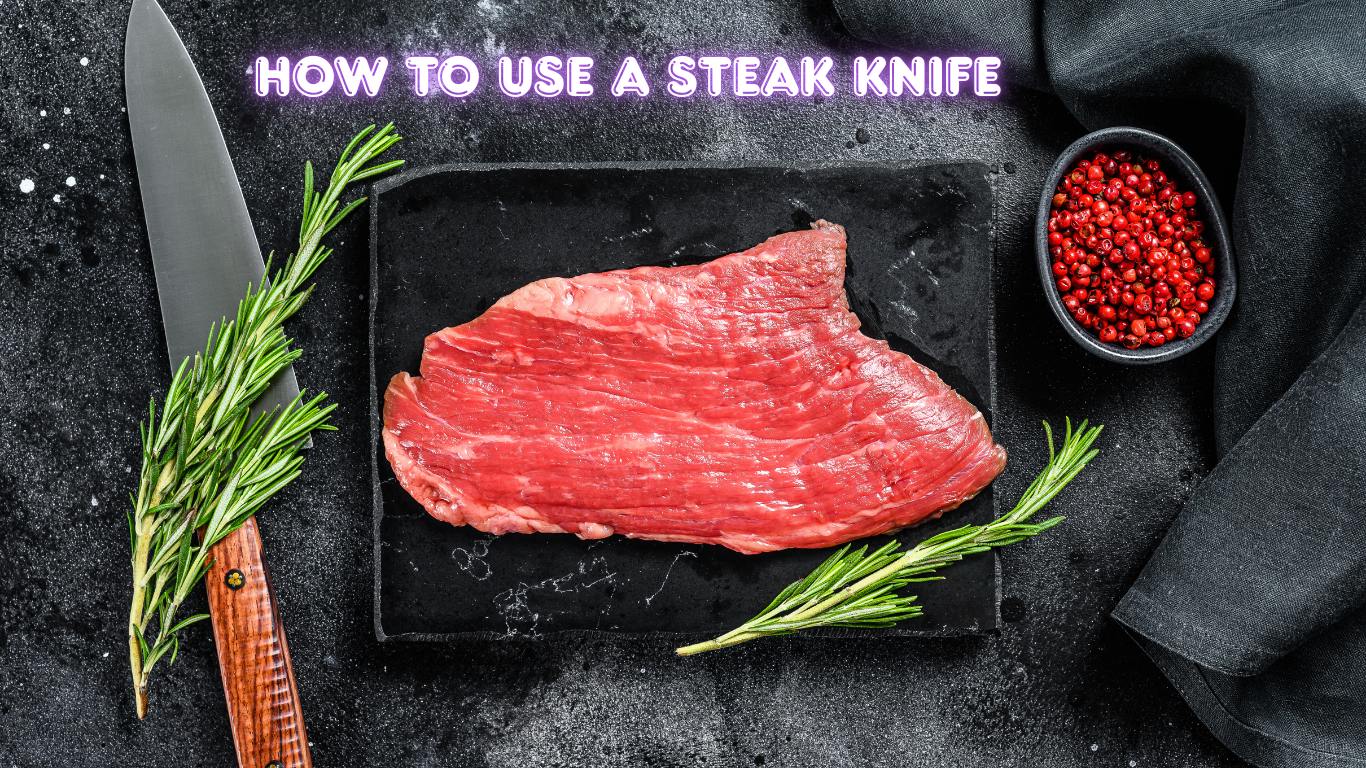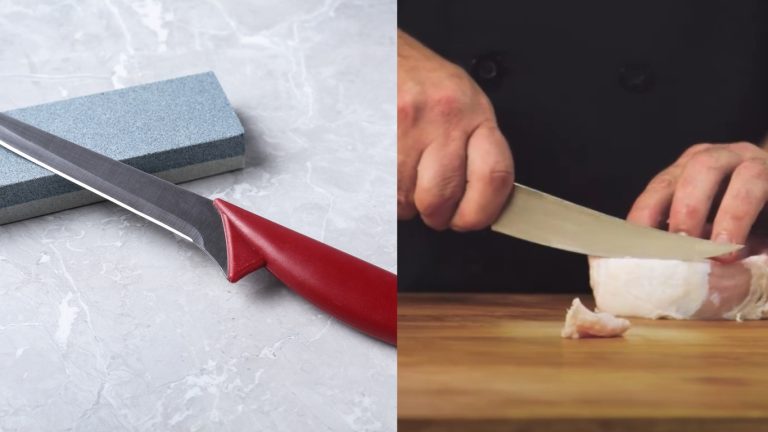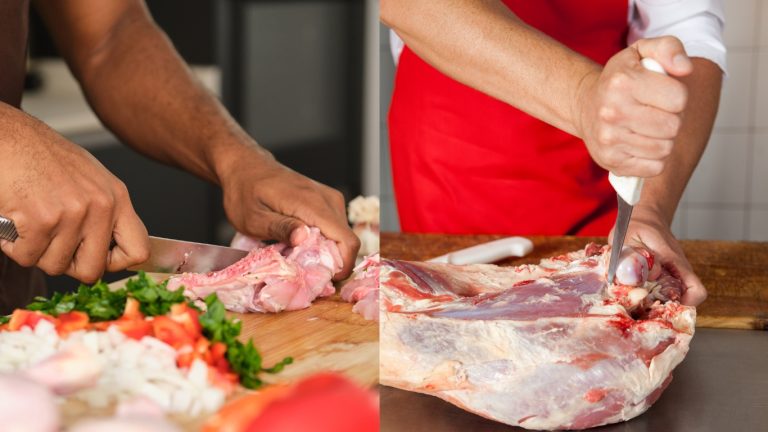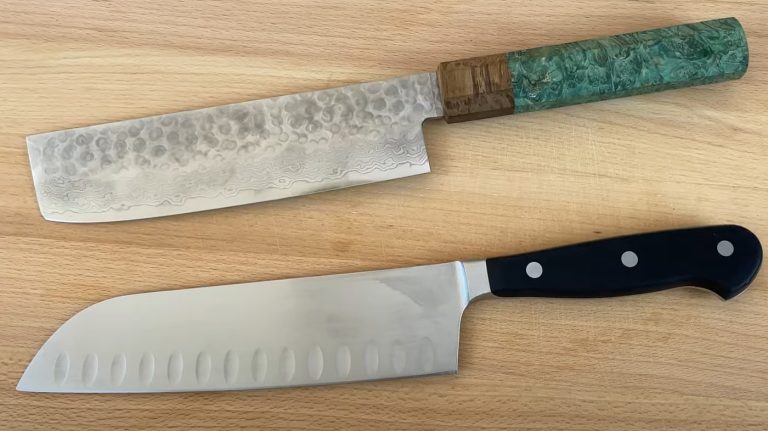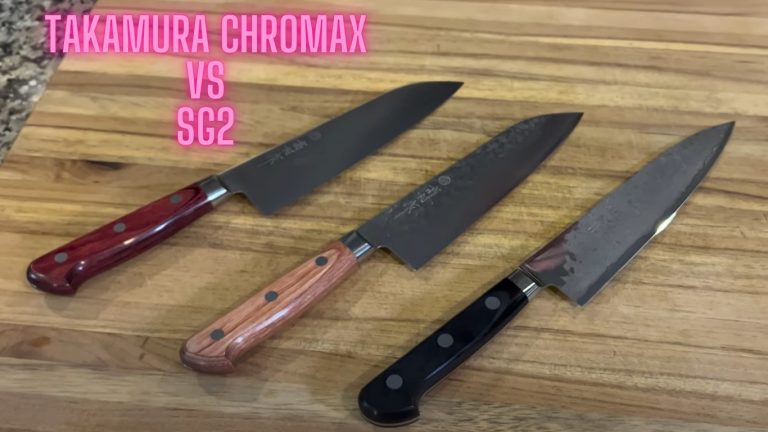How to Use a Steak Knife: Cut With Confidence
To use a steak knife, grip it firmly in your dominant hand, wrapping your middle, ring, and pinky fingers around the handle while extending your index finger along the top for control.
Keep your thumb on the side for stability. Slice against the steak’s grain with long, steady motions for tenderness, using a sharp blade on a stable cutting board.
Cut away from your body. Explore further to master additional techniques.
Key Takeaways
- Grip the steak knife firmly in your dominant hand using a pinch grip for control.
- Slice against the grain at a 90-degree angle for tender steak cuts.
- Use long, sweeping motions with a sharp knife, holding steak steady with tongs.
- Cut away from your body on a stable cutting board for safety.
- Rest the knife on the plate edge when not in use for hygiene.
Mastering the Proper Grip
Precision there, steak enthusiasts! Let’s dive into mastering the proper grip for using a steak knife with precision and style.
Precision is key when mastering the proper grip for a steak knife. Hold the knife in your dominant hand, guaranteeing the handle rests securely in your palm.
Wrap your middle, ring, and pinky fingers around it, keeping the grip firm yet relaxed. Don’t clench like you’re wielding a hammer; control comes from ease. For optimal performance, select a steak knife featuring full-tang construction to maintain balance and control.
Place your index finger straight along the top of the handle, near the blade’s base, for stability. Rest your thumb along the side for counter-pressure.
Avoid pointing your index finger down the blade’s spine—that’s a rookie mistake. Whether you adopt the efficient Continental style, with a hidden handle grip, or the American zigzag method, consistent hand placement guarantees you’re in command every time you cut.
Techniques for Effective Cutting
How can you transform a tough steak into a tender, mouthwatering bite?
Start by identifying the grain—those subtle lines of muscle fibers—and position the steak so they run parallel to your cutting board’s longest side.
Always slice against the grain, cutting perpendicular to the fibers at a 90-degree angle, to shorten them for maximum tenderness.
Slice against the grain, cutting at a 90-degree angle to the fibers, ensuring each bite is tender and effortless.
Use long, sweeping motions with a sharp knife, holding the steak steady with tongs for control.
Let the steak rest 5-10 minutes before cutting to redistribute juices, ensuring a moist result.
Opt for thinner slices, around ¼ inch, especially for tougher cuts, and cut on a 45-degree bias to enhance tenderness further.
This technique is especially effective for tougher cuts like flank or skirt steak, where the grain visibility is more pronounced. These techniques can also be applied to brisket cuts for similar tenderness and flavor enhancement.
Understanding Steak Knife Styles
Explore into the world of steak knife styles, and you’ll quickly see that not all blades are created equal.
You’ve got options like serrated edges, which grip and tear through tough cuts with ease, though they might shred fibers.
Straight edges, often seen in premium Laguiole or Japanese designs, deliver clean, precise slices, preserving meat juices.
Hollow edges, less common, aim for finer cuts with air pockets to prevent sticking.
Micro-serrated and hybrid blades offer varied performance, while materials matter too.
Choose stainless steel for durability, high-carbon stainless for sharpness, or Damascus for beauty and edge.
For superior performance in kitchen tasks, options like Takamura Chromax or SG2 steel offer excellent edge retention.
Pick carbon steel if you’re ready for meticulous care.
Ceramic knives, known for their exceptional hardness, also provide long-lasting sharpness without rusting concerns exceptional hardness.
Observing Dining Manners
When using a steak knife, make sure you place it correctly on the right side of your dinner plate with the blade facing inward, maintaining a polished table setup.
Don’t ever use the knife to gesture or point during conversation, as this can come across as rude or aggressive. This aligns with proper table manners to ensure a respectful dining experience.
Keep your focus on proper etiquette to elevate your dining presence with confidence.
Additionally, ensure the steak knife rests on the edge of the plate when not in use, prioritizing safety and hygiene.
Proper Knife Placement
Mastering proper knife placement at the dining table showcases your attention to detail and respect for etiquette. When setting the table, position the steak knife to the right of the plate, blade facing inward, replacing the dinner knife or placed closest to the plate.
Make sure utensils follow usage order—furthest out for first use. This arrangement also enhances food presentation for a better visual appeal during meals.
Use this guide for precision:
| Setting | Steak Knife Placement |
|---|---|
| Basic | Replaces dinner knife, right of plate |
| Informal | Replaces or adds to dinner knife, right side |
| Formal | Right of plate, closest or next to dinner knife |
Avoiding Rude Gestures
Proper knife placement sets the stage for a refined dining experience, but how you handle your steak knife and behave at the table matters just as much.
Don’t wave or point with your knife while talking; use words instead.
Hold it gently, with your index finger and thumb for control, never gripping it like a hammer.
Avoid licking the knife or letting it near your mouth—it’s impolite and unsafe.
At the table, keep elbows off, chew quietly with your mouth closed, and don’t reach across for items—ask politely.
Pace yourself, savor each bite, and wait for everyone to be served before starting.
Put utensils down when speaking, and never use them for unintended purposes.
When not in use, rest your knife on the plate edge with the blade facing inward.
Prioritizing Safety Measures
As you wield a steak knife, prioritizing safety measures is paramount to prevent accidents and guarantee a seamless cutting experience.
Grip the handle firmly, not overly tight, and extend your index finger along the spine for control.
Always cut away from your body with steady, controlled movements, using a sawing motion on a stable cutting board.
Stay focused—don’t let distractions pull your attention.
Maintain bright lighting and a clutter-free workspace.
Keep a safe distance from others, creating a “safety circle.”
When passing the knife, offer the handle first or place it on a surface.
Carry it with the blade down, edge away, and never catch a falling knife—step back instead.
These precautions guarantee your safety every time.
Additionally, using a high-quality steak knife with a sharp blade ensures clean cuts without excessive force.
Caring for Your Blade
When caring for your steak knife, start by cleaning it right after use with warm water and mild soap, using a soft cloth to avoid scratches.
Make sure you dry it thoroughly with a clean microfiber or cotton towel to prevent rust and water spots.
For maintaining a sharp edge, hone the blade every few uses with a rod and consider professional sharpening annually to maintain peak performance.
When honing, hold the rod at a 15° to 22° angle for effective edge alignment.
Additionally, applying a thin layer of food-grade mineral oil can help protect the blade from environmental factors like moisture and air food-grade mineral oil.
Cleaning After Use
After enjoying a meal with your steak knife, don’t let lingering food residues compromise its quality. Act fast to maintain its edge and prevent corrosion from food acids. To prevent rust formation, ensure the knife is dried completely after washing to avoid moisture buildup that could lead to bacterial risks.
Rinse it under warm water immediately to clear debris, then hand wash with mild dish soap and a soft sponge. Remember to wash your knife immediately after use to prevent food particles from drying on the blade prevent drying particles.
Avoid abrasive tools that’ll scratch the blade, and never toss it in the dishwasher—harsh detergents and heat can ruin the temper and handle.
Keep your cleaning precise with these steps:
- Wash one knife at a time; don’t pile them in the sink.
- Wipe from spine to edge carefully, keeping the sharp side away from your hands.
- For stuck food, soak briefly in shallow water, no longer than two minutes.
Proper Drying Techniques
Take charge of your steak knife’s longevity by mastering proper drying techniques right after cleaning. Don’t let your blade air dry; rust and water spots can form.
Instead, grab a clean, soft, absorbent towel—microfiber, cotton, or paper towels work best—and dry the blade, handle, spine, heel, and crevices thoroughly.
Rinse with warm water first to speed evaporation, then confirm dryness by feeling the surface. For enhanced rust prevention, you can occasionally treat your knife with white vinegar as part of your care routine.
Use a dedicated towel to avoid contamination and wipe gently to prevent scratches. For carbon steel knives, dry immediately after cutting acidic foods to stop rust.
Apply a thin coat of food-grade mineral oil post-drying to shield against humidity. This practice helps maintain the blade’s condition over time preventing moisture damage.
Regular Sharpening Tips
How can you guarantee your steak knife remains a precision tool at every meal?
It’s all about regular sharpening and maintenance. Remember that the optimal sharpening angle can vary based on your knife’s steel composition for better edge stability and performance.
You don’t need to sharpen often—once or twice a year for home use suffices—but honing with a steel should be frequent, even weekly, to realign the edge.
Know the difference: honing maintains, while sharpening renews by removing metal.
To keep that edge razor-sharp, follow these essentials:
- Use a whetstone or diamond stone for sharpening, maintaining a 15-20 degree angle with light pressure.
- Hone regularly with a ceramic or steel rod to preserve the blade between sharpenings.
- For serrated blades, sharpen each gullet individually with a tapered rod, avoiding the flat side.
- Timely sharpening enhances cutting efficiency and ensures cleaner cuts at the table.
Choosing the Right Tool
When selecting a steak knife, you’re making a decision that directly impacts your dining experience. If you prefer superior edge retention, consider carbon steel knives, which are known for their fine grain structure.
Opt for high-carbon stainless steel blades for durability and sharpness, or ceramic if you want lightweight, rust-proof performance.
Choose a straight edge for precise, clean cuts, or a serrated edge if you’re tackling tougher meats—know that straight edges are easier to maintain.
Consider the handle—synthetic materials like G-10 offer durability and grip, while full tang construction provides strength and balance for heavy use.
Don’t overlook fit and finish; seams should be flawless.
Prioritize quality over tang type in high-end options.
Additionally, consider hybrid knives that combine serrated and straight edges for versatile cutting performance.
Enhancing Your Dining Experience
Selecting the ideal steak knife sets the stage for a superior meal, but it’s your approach to using it that truly elevates the moment. Master the art of cutting against the grain with smooth, long strokes to achieve tenderness and retain juices.
Handle your knife with precision—index finger along the spine for control—and follow proper etiquette to exude confidence. By cutting at a 45-degree angle, you can increase surface area for faster, more even cooking.
Choosing the perfect steak knife is just the start. Master cutting against the grain with precision to elevate every dining moment.
Enhance your experience with these key practices:
- Slice on a 45-degree bias and fan the pieces for stunning presentation.
- Arrange your plate thoughtfully, letting the steak shine with balanced sides and minimal garnish.
- Rest utensils correctly, signaling pauses or completion with poised placement.
Frequently Asked Questions
Can Steak Knives Be Used for Other Meats?
You can absolutely use steak knives for other meats beyond just steak. With their sharp blades, they’re perfect for slicing roasts, pork chops, poultry, and lamb dishes.
Cut through tough fibers cleanly, whether you’ve got a straight or serrated edge. They handle large sausages or cured meats too.
Rely on their versatility and high-quality steel to tackle any meat dish with precision and ease at your table.
Are Steak Knives Suitable for Cutting Bread?
Imagine you’re hosting a dinner, and by chance, your bread knife’s missing. You grab a steak knife instead. Are steak knives suitable for cutting bread? With precision, I’ll tell you they’re not ideal.
Serrated steak knives can handle crusty bread in a pinch, but they’ll likely tear softer loaves. Their short blades can’t slice large loaves evenly. Stick to a proper bread knife for clean, expert cuts every time.
How Often Should Steak Knives Be Replaced?
Hey, when should you replace your steak knives?
It’s critical to monitor their condition closely.
If you spot rust, loose handles, or deep chips, don’t hesitate—replace them immediately for safety.
Struggling to cut meat or noticing poor balance? That’s a sign they’re past their prime.
Depending on use and care, replace every 5-10 years, or sooner if performance drops.
Trust your judgment; prioritize quality and safety always.
Can Children Safely Use Steak Knives?
Picture a tightrope walker, balancing skill and danger—that’s you considering if children can safely use steak knives. Don’t rush this decision.
Steak knives, with their sharp, serrated edges, aren’t suitable for young kids. Start with child-safe knives around age 2 under strict supervision.
Wait until they’re 7 or older, with proven skills, before introducing real knives. Always prioritize safety, proper grip, and constant guidance. You’ve got this!
Do Steak Knives Come in Sets Only?
Hey, let’s clear up if steak knives come in sets only.
They don’t!
You’ve got options to buy them individually from major retailers like Amazon or specialty shops like ZWILLING.
Brands such as Lamson even list single knives for purchase.
You can also grab sets of 4, 6, or more for uniformity and cost savings.
Choose what fits your needs—mix, match, or complete your collection with precision!
The Edge of Excellence Is Now in Your Hands
Now, you’ve got the skills to wield a steak knife with finesse, slicing through challenges like a knight through battle.
Let each cut be a stroke of mastery, turning every meal into a feast of triumph. Keep your blade sharp, your grip firm, and your manners polished.
With safety as your shield, you’re not just dining—you’re crafting memories. So, pick the right tool and carve your path to culinary glory.

